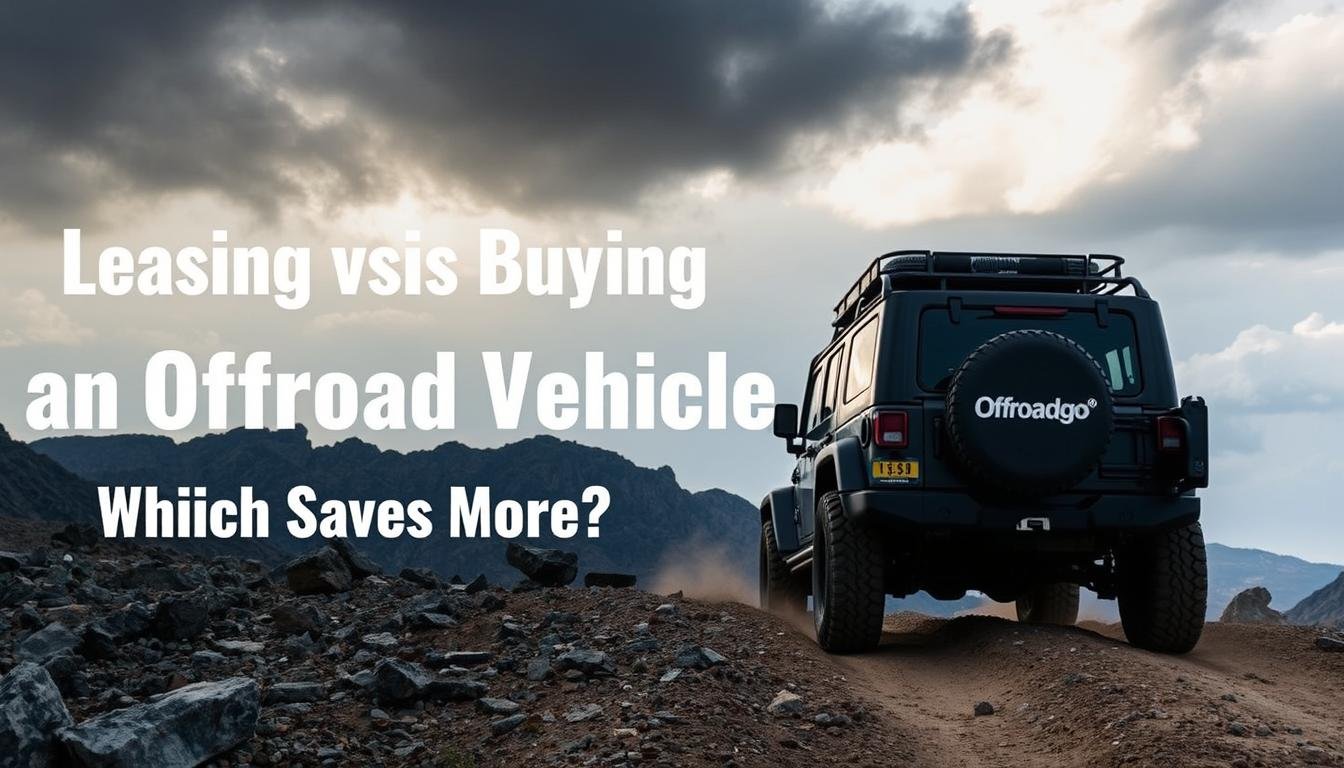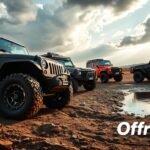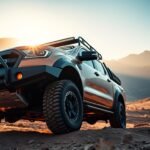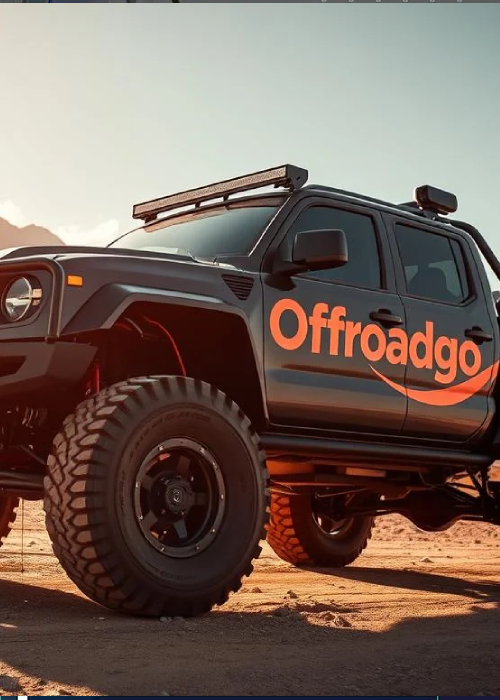The offroad adventure market is booming. Offroad leasing is becoming more popular among enthusiasts. The demand for SUVs has surged, affecting jeep finance options and suv ownership trends.
- Understanding Offroad Vehicles and Their Appeal
- Costs Involved in Leasing an Offroad Vehicle
- Costs Involved in Buying an Offroad Vehicle
- Pros of Leasing an Offroad Vehicle
- Cons of Leasing an Offroad Vehicle
- Pros of Buying an Offroad Vehicle
- Cons of Buying an Offroad Vehicle
- Impact of Interest Rates on Financing Options
- Current Trends in Interest Rates (2025)
- How Rates Affect Payments
- Comparison of Leasing and Buying with Interest in Mind
- Determining Your Driving Habits
- Evaluating Your Budget and Financial Goals
- Short-term vs Long-term Financial Planning
- Understanding Total Cost of Ownership
- Budgeting for Future Maintenance
- Making the Final Decision: Lease or Buy?
- Comparing Total Costs Over Time
- Individual Lifestyle Considerations
- How Family Needs Impact Your Choice
- Conclusion: Finding the Best Option for You
- FAQ
- What are the primary differences between leasing and buying an offroad vehicle?
- How do mileage restrictions impact leasing an offroad vehicle?
- What are the benefits of owning an offroad vehicle?
- How do interest rates affect financing options for offroad vehicles?
- What factors should be considered when evaluating budget and financial goals for offroad vehicle ownership?
- How do driving habits influence the decision to lease or buy an offroad vehicle?
- What are the long-term costs associated with buying an offroad vehicle?
- Can leasing an offroad vehicle provide access to the latest models and technological advancements?
- How does SUV ownership impact the decision to lease or buy an offroad vehicle?
- What are the implications of jeep finance on the overall cost of owning an offroad vehicle?
- How does offroad leasing impact the total cost of ownership?
When thinking about a new offroad vehicle, the choice between leasing or buying is tough. Leasing means lower monthly payments and access to the latest models. Buying, on the other hand, offers long-term ownership without mileage limits.
This article will dive into the costs, benefits, and downsides of leasing versus buying an offroad vehicle. It aims to help you make a well-informed choice.
Key Takeaways
- Lower monthly payments are a big plus of leasing an offroad vehicle.
- Buying means owning it long-term and could save money in the long run.
- Leasing lets you drive newer models with the latest tech.
- Buying gives you freedom to customize without limits.
- Financial factors, like bank rates and eligibility, are key in making your decision.
Understanding Offroad Vehicles and Their Appeal
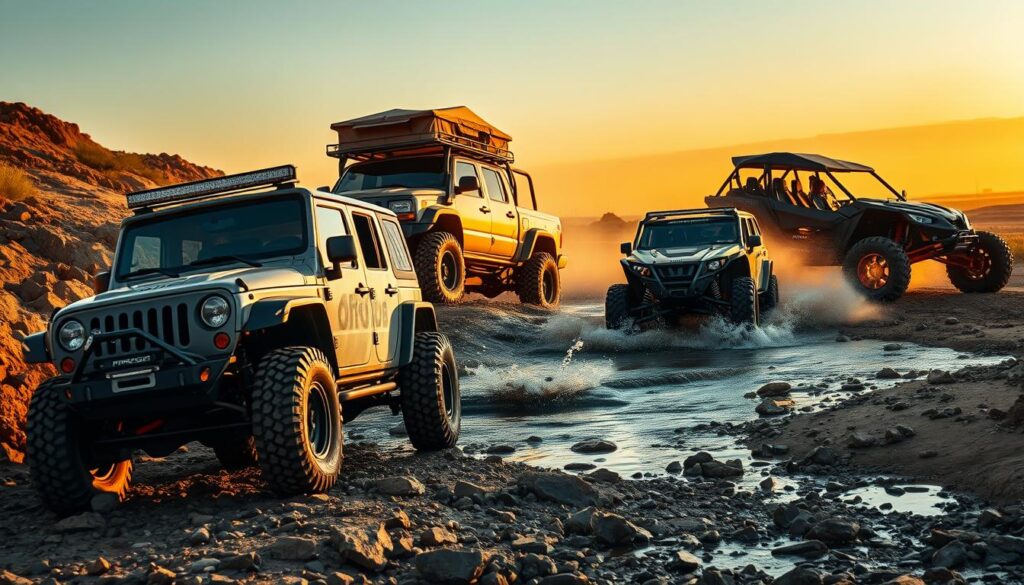
Offroad vehicles are great for tackling tough terrains. They offer a thrilling experience for those who love adventure and the outdoors. Whether you’re exploring new places or just enjoying the ride, offroad vehicles make every journey exciting.
Types of Offroad Vehicles Popular in 2025
In 2025, several offroad vehicles have become favorites. The Jeep Wrangler and Dodge Durango stand out. They are built for rough terrains, from rocky paths to sandy dunes.
Trucks and SUVs with high ground clearance and strong suspension systems are also popular. They make it easy to conquer tough terrains.
Key Features to Look For
When choosing an offroad vehicle, look for certain features. Four-wheel drive (4WD) capability is key for tough terrains. High ground clearance helps avoid damage from rocks and other obstacles.
A strong suspension system and heavy-duty tires are also important. They help withstand the challenges of offroad driving.
Benefits of Offroad Driving
Offroad driving has many benefits. It lets you explore new places and feel the thrill of the ride. It also helps improve your driving skills and boosts your confidence.
Offroad vehicles are perfect for camping, hiking, and other outdoor activities. They offer versatility and fun for those who love the outdoors.
Costs Involved in Leasing an Offroad Vehicle
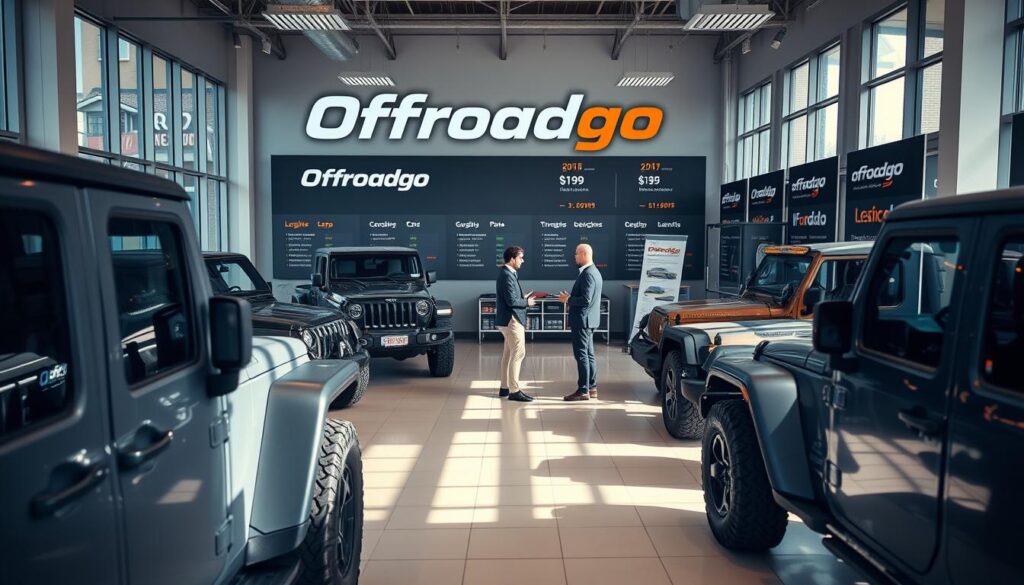
Thinking about leasing an offroad vehicle? It’s key to know all the costs. Leasing might seem cheaper at first, but you need to see the whole picture.
Monthly Payments Explained
Leasing a vehicle means lower monthly payments than buying. For example, a Jeep Wrangler lease can start at $300 a month. Your payment depends on the vehicle’s price, lease length, and what it’s worth at lease end.
Key factors influencing monthly payments:
- Vehicle MSRP
- Lease term
- Residual value
- Money factor (similar to interest rate)
Additional Fees and Costs
Leasing comes with extra fees. These include:
- Acquisition fee
- Disposition fee at lease end
- Excess wear and tear charges
- Mileage overage fees
Always read your lease agreement to know all costs.
Insurance Considerations
Insurance is a big part of leasing costs. Leasing companies want you to have comprehensive and collision insurance. This can raise your costs. Insurance prices change based on your driving history, where you live, and the vehicle’s value.
Knowing these costs helps you decide if leasing is right for you. By looking at all expenses, you can understand the financial side of your choice better.
Costs Involved in Buying an Offroad Vehicle
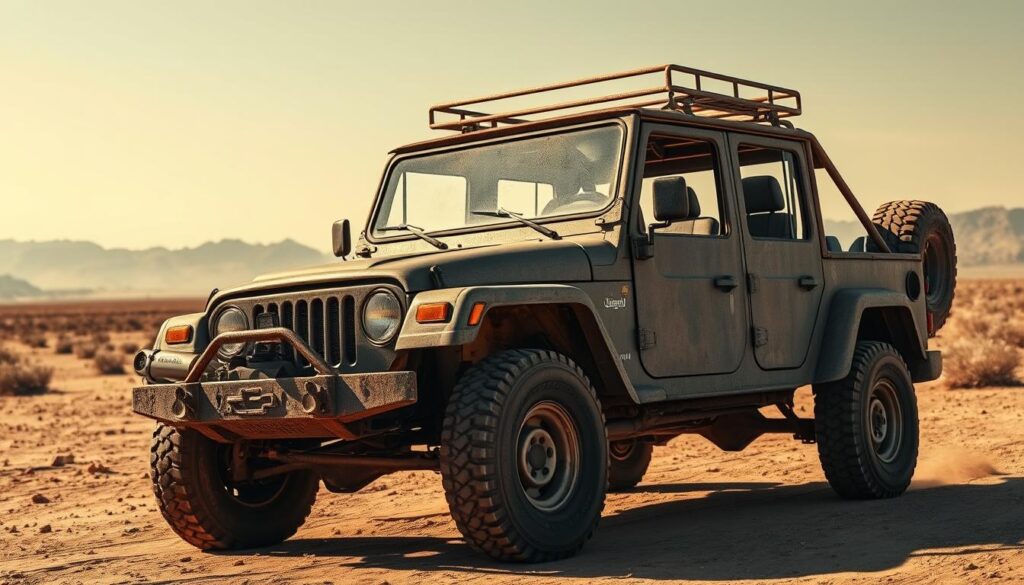
Buying an offroad vehicle can be expensive. You need to think about more than just the price you pay upfront. There are many other costs that can affect your budget.
Upfront Investment and Financing Options
The cost of an offroad vehicle starts with the purchase price. This price can change a lot based on the vehicle’s make, model, and features. If you can’t pay the full price, there are financing options available.
It’s important to look at different financing plans to find one that fits your budget. Some people choose loans with longer terms to lower their monthly payments. Others prefer shorter terms to pay less interest over time.
When looking at financing, it’s key to know the interest rates and terms from different lenders. Comparing these can help you get a better deal, saving you money.
Long-term Expenses to Consider
There are costs beyond the initial purchase price. These include:
- Fuel costs, which can be higher for offroad vehicles due to their size and power.
- Maintenance and repair costs, as offroad driving can be harsh on vehicles.
- Insurance premiums, which may be higher for offroad vehicles due to their value and the risks associated with offroad driving.
Breaking down these costs can help you understand the total cost of owning an offroad vehicle. Here’s a table showing some key long-term expenses:
| Expense Type | Average Annual Cost | 5-Year Total |
|---|---|---|
| Fuel | $2,000 | $10,000 |
| Maintenance & Repairs | $1,000 | $5,000 |
| Insurance | $1,500 | $7,500 |
Resale Value and Depreciation
Another important thing to think about is the resale value and depreciation of an offroad vehicle. These vehicles can lose value quickly, especially if used a lot for offroad driving. Knowing how different models hold their value can help you make a better choice.
Looking into the resale value of different models and their depreciation rate can help you see if a purchase is cost-effective in the long run. Some offroad vehicles keep their value better than others, making them a more economical choice.
Pros of Leasing an Offroad Vehicle
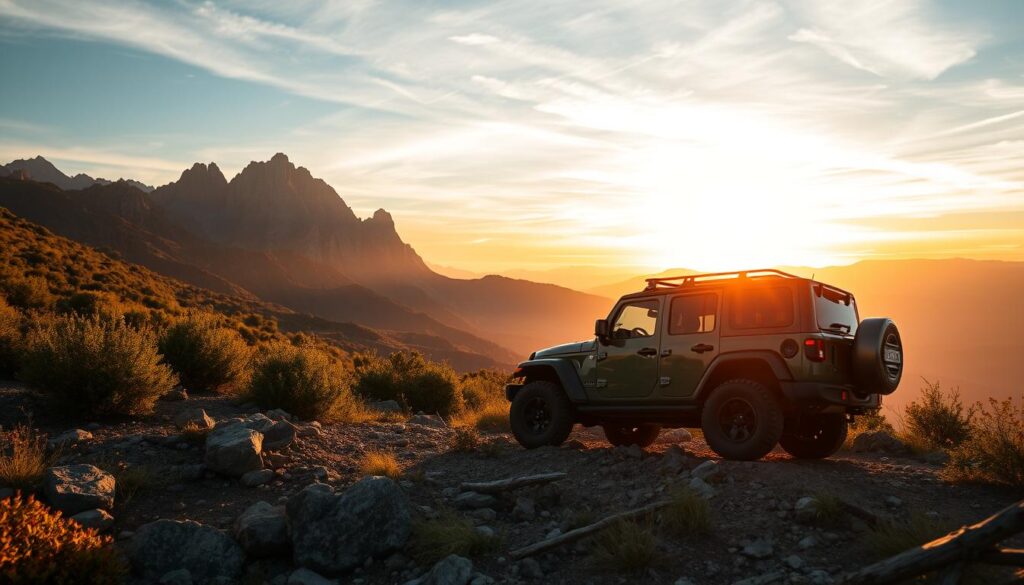
Leasing offroad vehicles is becoming more popular. It offers benefits like lower monthly payments and access to the latest models. This way, you can drive a new vehicle without the long-term costs of buying.
Lower Monthly Payments
Leasing an offroad vehicle means lower monthly payments. For example, leasing a Jeep Grand Cherokee 4xe can save you money. It makes owning a high-quality offroad vehicle more affordable.
Lease payments cover the vehicle’s depreciation, not the full price. This is great for those who want a premium offroad vehicle without the high cost.
Access to Latest Models
Leasing lets you drive the newest offroad models. These vehicles come with the latest features and technologies. This is perfect for those who love the latest in offroad driving.
With leasing, you can switch to a new model every few years. This means you always have the latest offroad capabilities and safety features. It makes offroad driving more enjoyable and safe.
Maintenance Typically Covered
Many leases include maintenance packages. These cover routine services and repairs. This can save you money and give you peace of mind.
For instance, a lease for a Jeep Wrangler might include maintenance for oil changes, tire rotations, and more. This keeps your vehicle in top shape during the lease.
Cons of Leasing an Offroad Vehicle
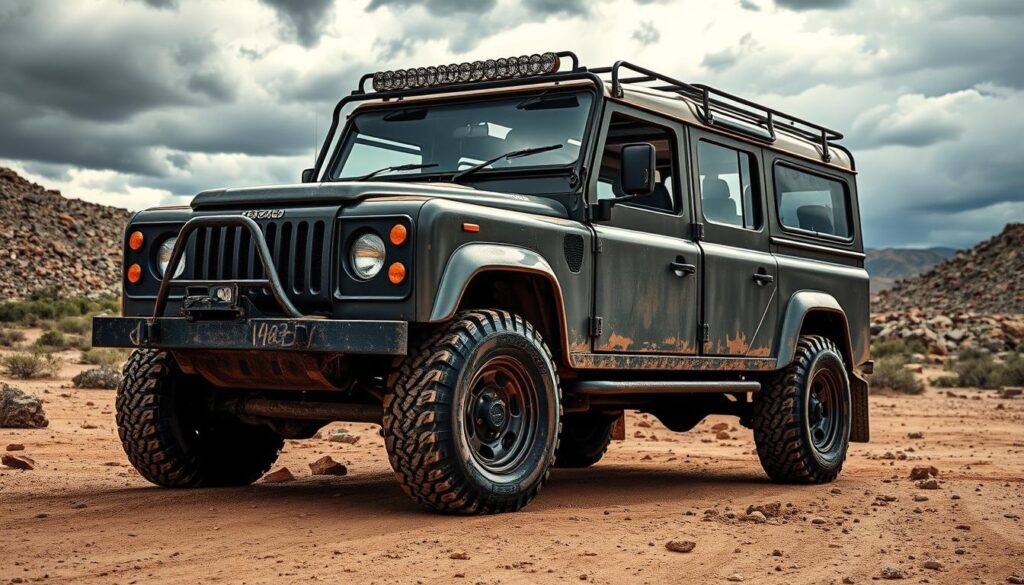
Leasing an offroad vehicle has its downsides. It’s important to know these to make a choice that fits your needs and budget.
Mileage Restrictions
Leases often have mileage limits. Going over this can lead to extra fees. This is a big issue for offroad fans, as their vehicles rack up miles fast.
“Excess mileage fees can add up quickly, making it essential to estimate your annual mileage before signing a lease.” If you love offroading, talk about higher mileage limits in your lease. Or, be ready for extra fees.
Lack of Ownership
When your lease ends, you can’t keep the vehicle unless you buy it. This means you can’t change it up or sell it later.
Experts say,
“leasing lets you drive new cars often, but you lose the chance for long-term ownership and building equity.”
This is something to think about if you like owning things.
Potential for Additional Charges
Leases can have extra fees. These include charges for wear and tear, going over mileage, and ending the lease early.
It’s key to read the lease carefully. Knowing these fees can help you avoid surprises and make a better choice.
Pros of Buying an Offroad Vehicle
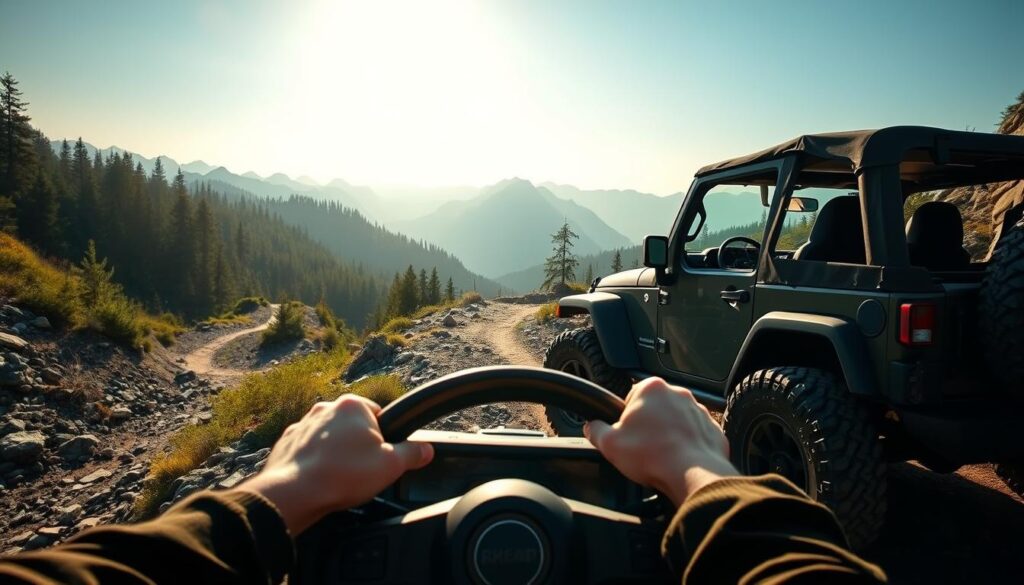
Buying an offroad vehicle gives you a sense of ownership and flexibility. Leasing can’t match this. Many enthusiasts love the freedom to use their vehicle as they please, without leasing’s limits.
Ownership and Freedom
Buying an offroad vehicle means you own it. You can modify it to fit your style, like upgrading the engine or adding custom accessories. For example, owning a Jeep Wrangler lets you customize it fully, making it truly yours.
No Mileage Limits
Unlike leasing, which limits miles, buying an offroad vehicle lets you drive as much as you want. This is great for those who love long offroad trips or live in areas with lots of driving.
Customization Options
Customizing your offroad vehicle is a big plus of buying. You can make it better, look better, or do more. With options like lift kits and custom paint, you can make it your own.
| Feature | Buying | Leasing |
|---|---|---|
| Ownership | Yes | No |
| Mileage Limits | No Limits | Typically Limited |
| Customization | Full Customization | Limited |
In summary, buying an offroad vehicle has many benefits. You get ownership, no mileage limits, and lots of customization options. These reasons make buying a great choice for many offroad fans.
Cons of Buying an Offroad Vehicle
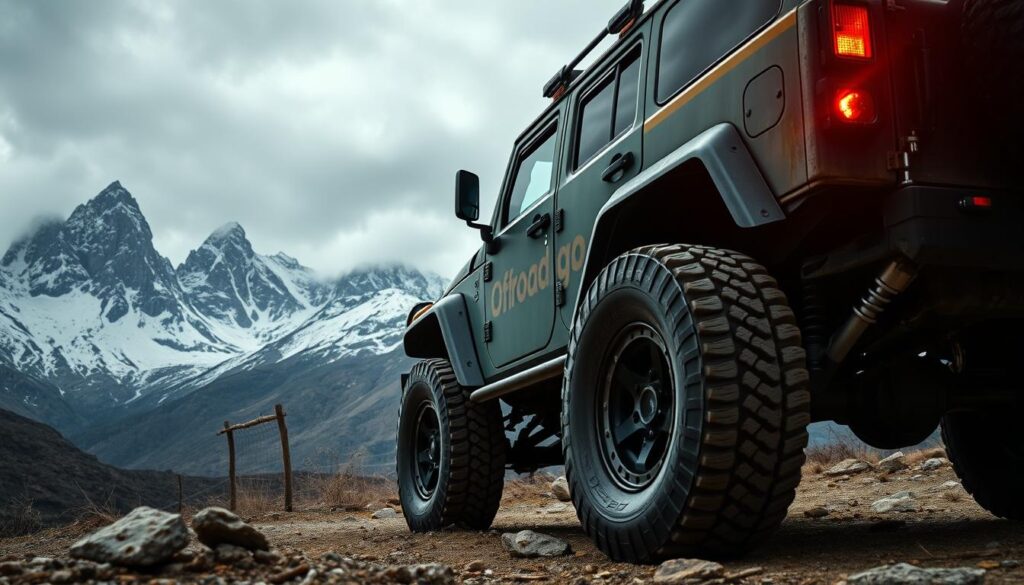
Before you decide to buy an offroad vehicle, think about the downsides. Buying one can affect your money and how you feel about owning it.
Higher Monthly Payments
Offroad vehicles usually mean higher monthly payments than leasing. This is because you’re paying off the full price and interest on the loan.
For example, financing a $50,000 offroad vehicle for 5 years at 6% interest means monthly payments of about $966. This can really hurt your budget and limit your spending.
Depreciation Concerns
Offroad vehicles, like all cars, lose value over time. The drop in value can be big, especially in the first years.
A study by Edmunds shows that some offroad vehicles can lose up to 50% of their value in 3 years. This can be a big financial hit if you sell your vehicle.
Maintenance Responsibilities
Buying an offroad vehicle means you’re in charge of its upkeep and repairs. This includes regular services and big fixes.
The cost of keeping an offroad vehicle running can vary. But, a study by RepairPal found that the average yearly maintenance cost for a 4×4 is about $1,200.
| Cost Category | Estimated Annual Cost | 5-Year Total |
|---|---|---|
| Loan Payments | $11,592 | $57,960 |
| Maintenance and Repairs | $1,200 | $6,000 |
| Insurance | $1,500 | $7,500 |
| Total | $14,292 | $71,460 |
It’s important to know these costs and responsibilities before deciding to buy or lease an offroad vehicle. By thinking about these things, you can make a choice that fits your budget and driving needs.
Impact of Interest Rates on Financing Options
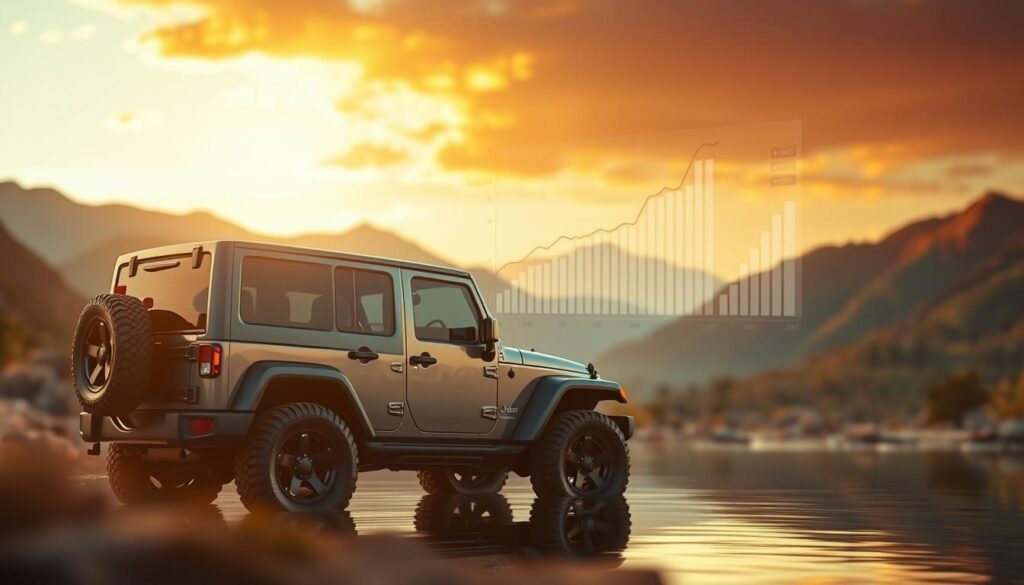
Interest rates change in 2025, affecting the costs of leasing or buying offroad vehicles. Jeep finance and other options see these changes, impacting both short and long-term costs.
Current Trends in Interest Rates (2025)
In 2025, interest rates will play a big role in how affordable offroad vehicles are. Rates might change, affecting the cost of financing. It’s important to keep up with these trends to make a smart choice.
Key factors influencing interest rates include the economy, Federal Reserve actions, and global markets. Knowing these can help guess future rate changes.
How Rates Affect Payments
Interest rates directly affect monthly payments for leasing and buying. Higher rates mean higher payments, raising the vehicle’s total cost.
- Leasing: Higher rates lead to higher monthly payments, as the lessor pays more for financing.
- Buying: Buyers face higher loan payments with higher rates, which can stretch budgets.
Comparison of Leasing and Buying with Interest in Mind
When looking at leasing versus buying, interest rates are key. Leasing might seem better with high rates, as it has lower upfront costs and payments. But buying can save money long-term if rates are low, since you won’t have monthly payments after the loan is paid off.
However, buying can be more cost-effective in the long run, especially if interest rates are low, as it eliminates the need for continuous monthly payments after the loan is paid off.
| Financing Option | Impact of Higher Interest Rates | Long-term Costs |
|---|---|---|
| Leasing | Higher monthly lease payments | Lower long-term costs due to return of vehicle |
| Buying | Higher loan payments | Potential for lower long-term costs with fixed loan |
The choice between leasing or buying an offroad vehicle should be well thought out. Consider current interest rates, your financial goals, and how you drive.
Determining Your Driving Habits
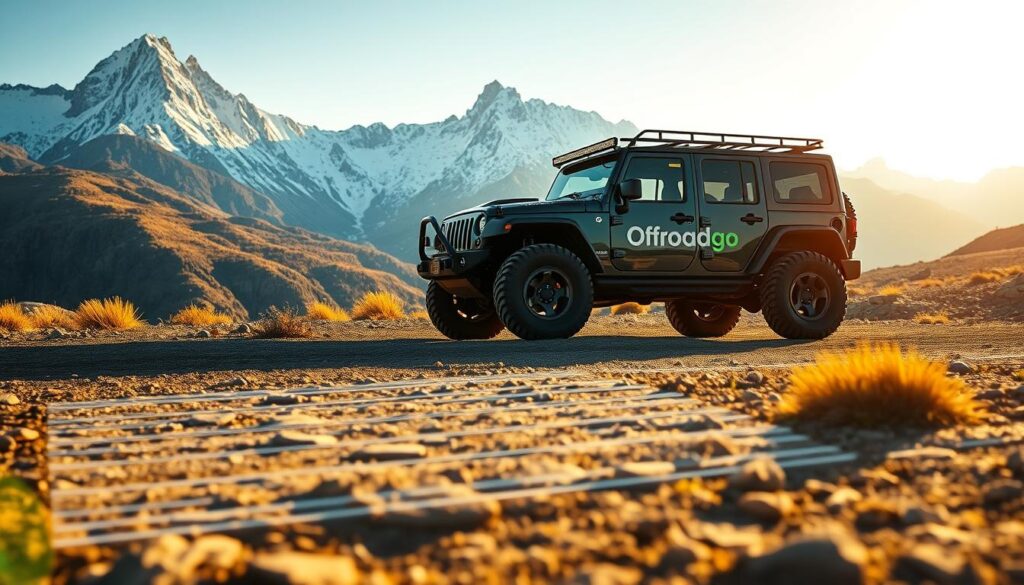
It’s important to know your driving habits when choosing between leasing and buying an offroad vehicle. Think about how often you go offroad, the conditions you drive in, and how you use your vehicle. These factors can greatly affect your choice.
How Often Do You Go Offroad?
How often you go offroad is key. If you love exploring rough terrains, buying might be better. Leasing often has mileage limits.
But, if you only go offroad sometimes, leasing could save you money. It has lower monthly payments. Think about your driving habits over the last year to see which option fits your lifestyle better.
Seasonal Usage Considerations
Offroad driving might be seasonal for many. If you only go offroad during certain times, leasing could be more flexible. Leases can be adjusted to match your driving patterns, saving you money when you’re not using the vehicle.
On the other hand, owning a vehicle means costs all year. You’ll have to pay for insurance, storage, and maintenance, even when it’s not in use.
Cost-Effectiveness Based on Use
To show how leasing compares to buying based on your driving habits, look at this table:
| Driving Habits | Leasing Costs | Buying Costs |
|---|---|---|
| Frequent Offroading | High mileage fees | Depreciation and maintenance |
| Occasional Offroading | Lower monthly payments | Higher upfront costs |
| Seasonal Offroading | Flexible lease terms | Year-round ownership costs |
By looking at your driving habits and the costs of leasing versus buying, you can make a better choice. This choice should fit your offroad lifestyle and budget.
Evaluating Your Budget and Financial Goals
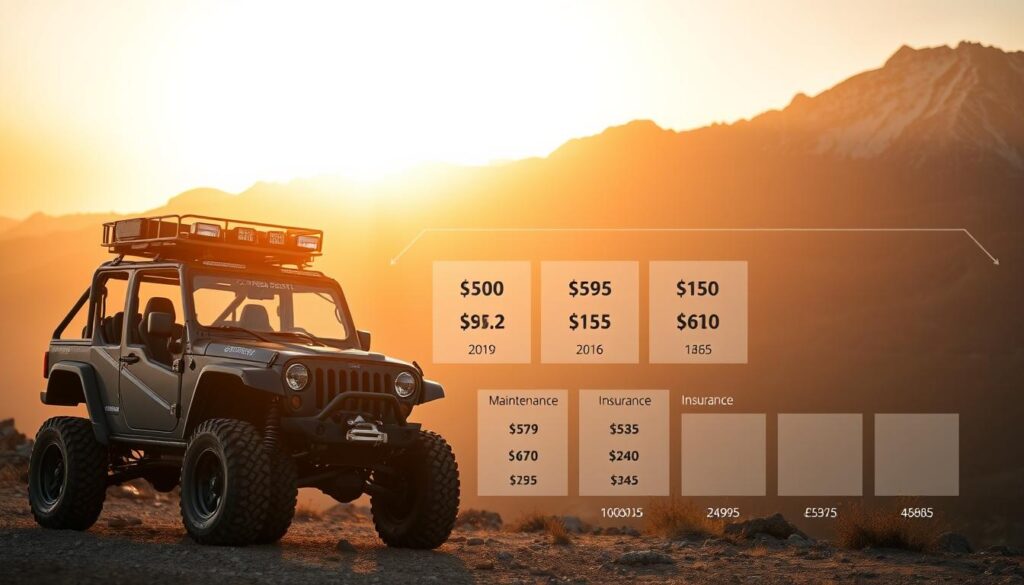
Understanding your budget and financial goals is crucial when deciding on an offroad vehicle. It’s important to weigh the pros and cons of leasing versus buying. This decision should align with your current and future financial plans.
Short-term vs Long-term Financial Planning
It’s key to separate short-term and long-term financial planning. Short-term planning looks at your current finances, like income, expenses, and savings. Long-term planning considers how your choice will affect your finances in the next few years.
For example, buying might be better if you plan to keep the vehicle long-term. But, if you like to change vehicles often, leasing could save you money upfront and offer more flexibility.
Understanding Total Cost of Ownership
The total cost of owning a vehicle includes more than just the purchase price or lease payments. It also includes insurance, maintenance, fuel, and repair costs. When calculating this total, consider the following:
- Purchase price or lease payments
- Insurance premiums
- Fuel and maintenance costs
- Potential repair costs
As “The total cost of ownership is a critical factor in determining the true cost of your offroad vehicle.” Knowing these costs helps you decide if leasing or buying is better for your budget.
Budgeting for Future Maintenance
Maintenance costs can greatly affect the total cost of ownership. When planning your budget, remember to save for regular maintenance like tire rotations and oil changes. Also, set aside money for unexpected repairs.
“A well-planned budget is the foundation of a stress-free offroad vehicle ownership experience.”
By carefully evaluating your budget and financial goals, you can make a more informed decision about whether leasing or buying an offroad vehicle is best for you.
Making the Final Decision: Lease or Buy?
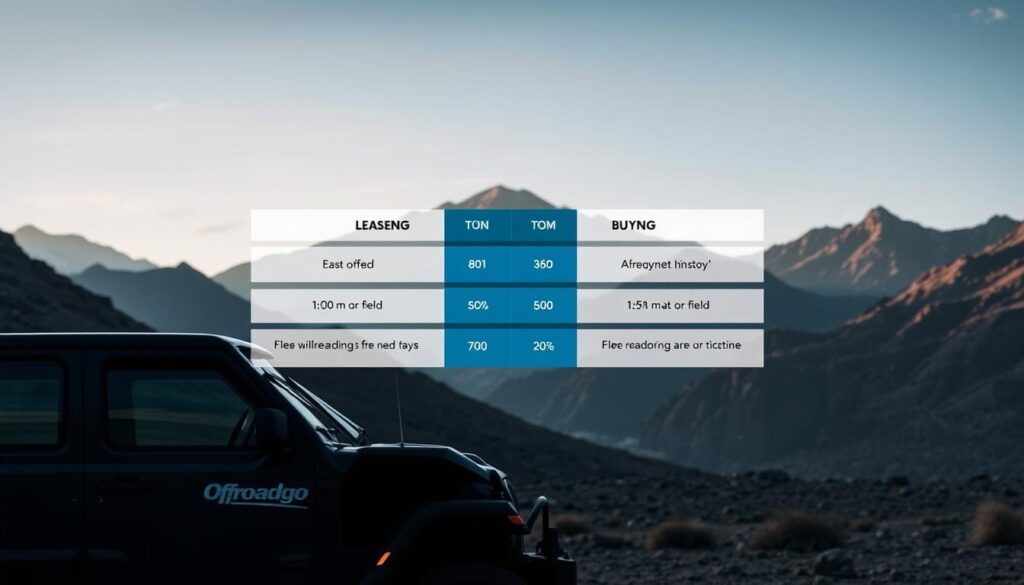
Choosing between leasing and buying an offroad vehicle requires careful thought. You need to look at financial and personal factors. These can greatly affect your choice.
Comparing Total Costs Over Time
Leasing an offroad vehicle means lower monthly payments. You only pay for the vehicle’s depreciation during the lease, plus interest and fees. Buying, however, requires a big upfront payment or financing. This can lead to higher monthly payments.
But, once you’ve paid off the loan, you own the vehicle. You won’t have to worry about monthly payments anymore.
Leasing comes with mileage limits and wear-and-tear charges. These can increase costs if not managed well. Buying means you’ll pay for maintenance after the warranty ends. As “The New York Times” says, “The total cost of ownership includes not just the purchase price, but also ongoing expenses like fuel, insurance, and maintenance.”
Individual Lifestyle Considerations
Your lifestyle affects whether leasing or buying is better. If you like driving new models and don’t want to own long-term, leasing might be best. If you keep vehicles for a long time and customize them, buying could save money in the long run.
“Leasing allows you to drive a new vehicle every few years, which can be beneficial if you like having the latest technology and safety features.”
How Family Needs Impact Your Choice
Family needs are key to your decision. Families with many drivers might prefer leasing. It offers a lower monthly payment, making it easier to afford a reliable offroad vehicle. Leasing also allows for more flexibility to switch vehicles if your family’s needs change.
- Consider the number of drivers in your household.
- Assess your budget for monthly payments versus upfront costs.
- Evaluate your need for the latest vehicle models and technologies.
Ultimately, your decision should be based on a detailed analysis of your finances, driving habits, and personal preferences. By considering these factors, you can make a choice that fits your needs.
Conclusion: Finding the Best Option for You
Choosing between leasing or buying an offroad vehicle depends on many things. Your budget, how you drive, and what you like are key. Leasing offers lower monthly payments and new models, while buying means owning and customizing.
Key Considerations
When thinking about suv ownership, remember the long-term costs. This includes maintenance and how much the vehicle will lose value over time. If you’re looking at jeep finance, knowing all the costs is important.
If you want to change vehicles often, offroad leasing might be for you. It lets you drive a new car every few years.
Next Steps
If you’re ready to decide, visit a place like Preston Chrysler Dodge Jeep Ram of Dover. They can help you understand both leasing and buying. Their experts will guide you to find what’s best for you and your budget.
Further Research
To make a smart choice, keep looking into the pros and cons of leasing versus buying. Think about your life, money goals, and how you’ll use the vehicle. With the right info, you can pick the best option for you.
FAQ
What are the primary differences between leasing and buying an offroad vehicle?
Leasing an offroad vehicle means lower monthly payments. You get to drive a new vehicle every few years. Buying means you own it outright. You have more freedom to customize it.
How do mileage restrictions impact leasing an offroad vehicle?
Mileage restrictions can lead to extra charges if you go over. This makes leasing less good for those who drive a lot or go on long trips.
What are the benefits of owning an offroad vehicle?
Owning an offroad vehicle gives you freedom to use it as you like. You can customize it to fit your needs. You also avoid mileage limits and extra charges that come with leasing.
How do interest rates affect financing options for offroad vehicles?
Interest rates can change how much you pay each month for leasing or buying. Higher rates mean higher costs over time.
What factors should be considered when evaluating budget and financial goals for offroad vehicle ownership?
When looking at budget and financial goals, think about short-term vs long-term plans. Consider the total cost of owning and budget for future maintenance. Make sure your choice fits your financial situation.
How do driving habits influence the decision to lease or buy an offroad vehicle?
Driving habits, like how often you go offroad, can affect whether leasing or buying is better. Those who drive a lot or use their vehicle for specific things might find one option more cost-effective.
What are the long-term costs associated with buying an offroad vehicle?
Buying an offroad vehicle comes with long-term costs. These include depreciation, maintenance, and repair costs. These can add up over time.
Can leasing an offroad vehicle provide access to the latest models and technological advancements?
Yes, leasing lets you drive a new vehicle every few years. This means you get the latest models, tech, and safety features.
How does SUV ownership impact the decision to lease or buy an offroad vehicle?
SUV ownership can affect your choice between leasing or buying. Those who already own an SUV might have different needs or preferences for their offroad vehicle.
What are the implications of jeep finance on the overall cost of owning an offroad vehicle?
Jeep finance options can change the cost of owning an offroad vehicle. The terms and interest rates affect your monthly payments and total cost.
How does offroad leasing impact the total cost of ownership?
Offroad leasing can lower your total cost by offering lower monthly payments and less upfront cost. However, it may have mileage limits and extra charges.

